Congestive Heart Failure: Risk Factors, Pathophysiology, Nursing Interventions and Drug Class
VerifiedAdded on 2023/04/25
|10
|2940
|85
AI Summary
This article discusses the risk factors, pathophysiology, nursing interventions and drug class for Congestive Heart Failure (CHF). It covers topics such as the causes of CHF, symptoms and their pathophysiology, drug classes like ACE inhibitors, and nursing interventions for patients with CHF. The article also includes references for further reading.
Contribute Materials
Your contribution can guide someone’s learning journey. Share your
documents today.
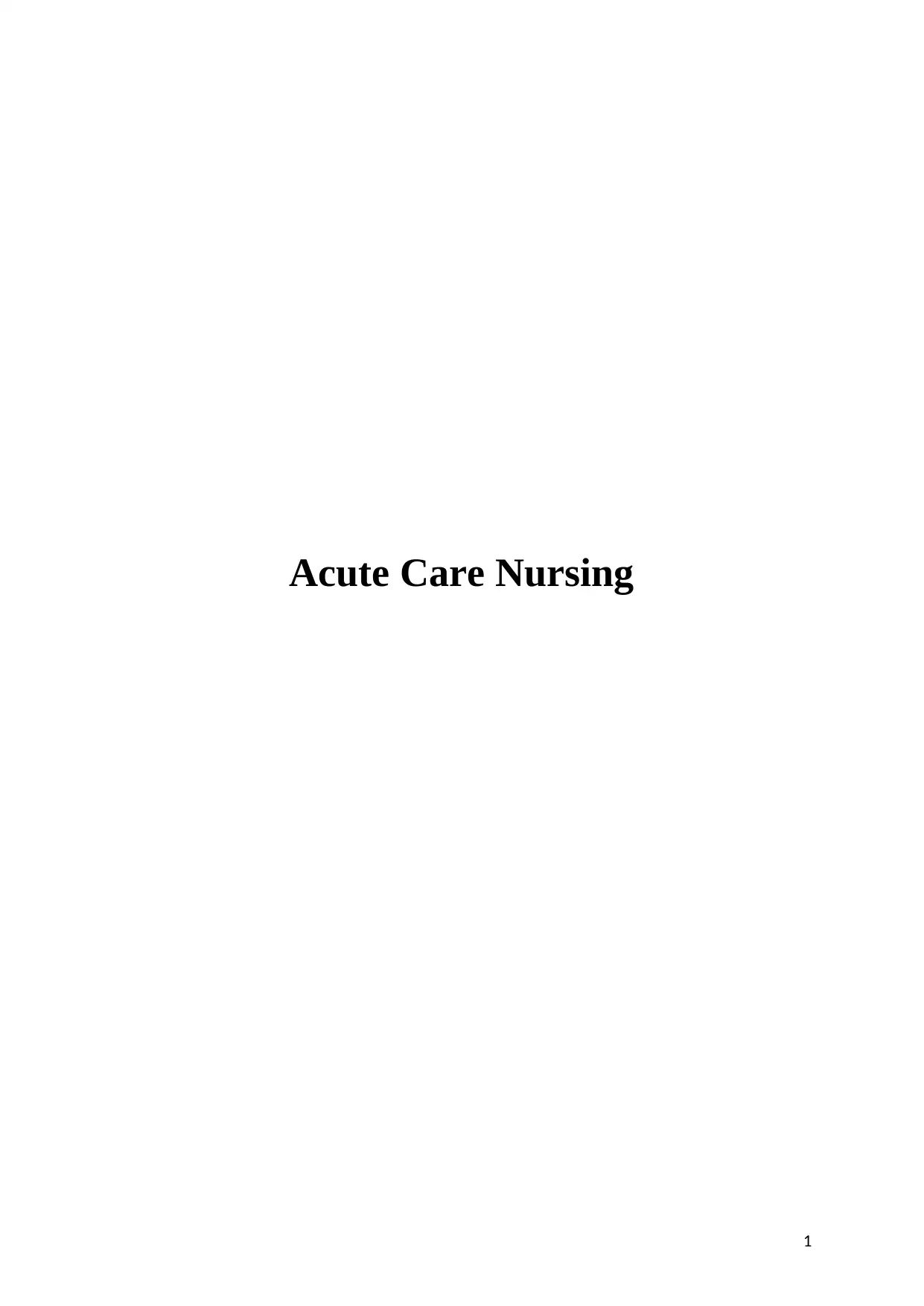
Acute Care Nursing
1
1
Secure Best Marks with AI Grader
Need help grading? Try our AI Grader for instant feedback on your assignments.
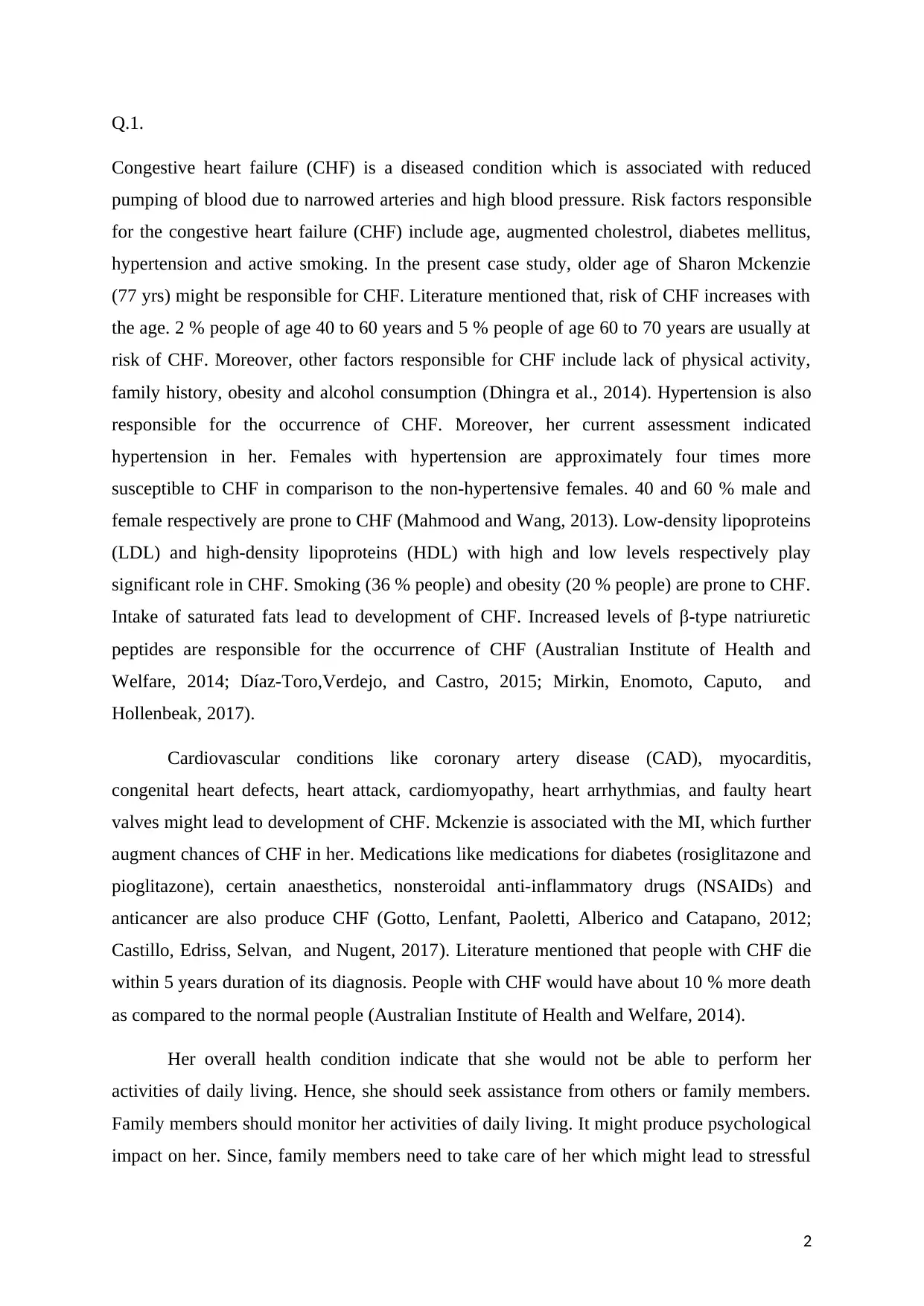
Q.1.
Congestive heart failure (CHF) is a diseased condition which is associated with reduced
pumping of blood due to narrowed arteries and high blood pressure. Risk factors responsible
for the congestive heart failure (CHF) include age, augmented cholestrol, diabetes mellitus,
hypertension and active smoking. In the present case study, older age of Sharon Mckenzie
(77 yrs) might be responsible for CHF. Literature mentioned that, risk of CHF increases with
the age. 2 % people of age 40 to 60 years and 5 % people of age 60 to 70 years are usually at
risk of CHF. Moreover, other factors responsible for CHF include lack of physical activity,
family history, obesity and alcohol consumption (Dhingra et al., 2014). Hypertension is also
responsible for the occurrence of CHF. Moreover, her current assessment indicated
hypertension in her. Females with hypertension are approximately four times more
susceptible to CHF in comparison to the non-hypertensive females. 40 and 60 % male and
female respectively are prone to CHF (Mahmood and Wang, 2013). Low-density lipoproteins
(LDL) and high-density lipoproteins (HDL) with high and low levels respectively play
significant role in CHF. Smoking (36 % people) and obesity (20 % people) are prone to CHF.
Intake of saturated fats lead to development of CHF. Increased levels of β-type natriuretic
peptides are responsible for the occurrence of CHF (Australian Institute of Health and
Welfare, 2014; Díaz-Toro,Verdejo, and Castro, 2015; Mirkin, Enomoto, Caputo, and
Hollenbeak, 2017).
Cardiovascular conditions like coronary artery disease (CAD), myocarditis,
congenital heart defects, heart attack, cardiomyopathy, heart arrhythmias, and faulty heart
valves might lead to development of CHF. Mckenzie is associated with the MI, which further
augment chances of CHF in her. Medications like medications for diabetes (rosiglitazone and
pioglitazone), certain anaesthetics, nonsteroidal anti-inflammatory drugs (NSAIDs) and
anticancer are also produce CHF (Gotto, Lenfant, Paoletti, Alberico and Catapano, 2012;
Castillo, Edriss, Selvan, and Nugent, 2017). Literature mentioned that people with CHF die
within 5 years duration of its diagnosis. People with CHF would have about 10 % more death
as compared to the normal people (Australian Institute of Health and Welfare, 2014).
Her overall health condition indicate that she would not be able to perform her
activities of daily living. Hence, she should seek assistance from others or family members.
Family members should monitor her activities of daily living. It might produce psychological
impact on her. Since, family members need to take care of her which might lead to stressful
2
Congestive heart failure (CHF) is a diseased condition which is associated with reduced
pumping of blood due to narrowed arteries and high blood pressure. Risk factors responsible
for the congestive heart failure (CHF) include age, augmented cholestrol, diabetes mellitus,
hypertension and active smoking. In the present case study, older age of Sharon Mckenzie
(77 yrs) might be responsible for CHF. Literature mentioned that, risk of CHF increases with
the age. 2 % people of age 40 to 60 years and 5 % people of age 60 to 70 years are usually at
risk of CHF. Moreover, other factors responsible for CHF include lack of physical activity,
family history, obesity and alcohol consumption (Dhingra et al., 2014). Hypertension is also
responsible for the occurrence of CHF. Moreover, her current assessment indicated
hypertension in her. Females with hypertension are approximately four times more
susceptible to CHF in comparison to the non-hypertensive females. 40 and 60 % male and
female respectively are prone to CHF (Mahmood and Wang, 2013). Low-density lipoproteins
(LDL) and high-density lipoproteins (HDL) with high and low levels respectively play
significant role in CHF. Smoking (36 % people) and obesity (20 % people) are prone to CHF.
Intake of saturated fats lead to development of CHF. Increased levels of β-type natriuretic
peptides are responsible for the occurrence of CHF (Australian Institute of Health and
Welfare, 2014; Díaz-Toro,Verdejo, and Castro, 2015; Mirkin, Enomoto, Caputo, and
Hollenbeak, 2017).
Cardiovascular conditions like coronary artery disease (CAD), myocarditis,
congenital heart defects, heart attack, cardiomyopathy, heart arrhythmias, and faulty heart
valves might lead to development of CHF. Mckenzie is associated with the MI, which further
augment chances of CHF in her. Medications like medications for diabetes (rosiglitazone and
pioglitazone), certain anaesthetics, nonsteroidal anti-inflammatory drugs (NSAIDs) and
anticancer are also produce CHF (Gotto, Lenfant, Paoletti, Alberico and Catapano, 2012;
Castillo, Edriss, Selvan, and Nugent, 2017). Literature mentioned that people with CHF die
within 5 years duration of its diagnosis. People with CHF would have about 10 % more death
as compared to the normal people (Australian Institute of Health and Welfare, 2014).
Her overall health condition indicate that she would not be able to perform her
activities of daily living. Hence, she should seek assistance from others or family members.
Family members should monitor her activities of daily living. It might produce psychological
impact on her. Since, family members need to take care of her which might lead to stressful
2

condition to other family members and produce economic burden on the family members.
Family members and care providers should monitor her diet, medications and risk factors.
Moreover, they should establish positive communication and positive approach with her
(Cooper, DeVore,and Michael Felker, 2015; Raman, 2016).
Q2. :
Symptom Pathophysiology
Dyspnoea Reduced cardiac output results in the decreased blood supply various
organs and tissues along with skeletal muscle. It produces augmented left
ventricular pressure to restore necessary cardiac output. Subsequently, it
leads to lessened pulmonary diffusion and subsequently interstitial oedema.
Breathlessness occur due to interstitial oedema. Increased expenditure of
myocardial energy occurs due to augmented diastolic pressure which
require increased amount of energy. Ventricular remodelling, increased
myocardial oxygen demand and myocardial ischemia occur due to raised
requirement of energy (Güde, Brenner, Störk, Hoes, and Rutten, 2014;
Hosenpud and Greenberg, 2013). From the case study, it is evident that
McKenzie is suffering through shortness of breath problem.
Swollen
ankle
In swollen ankle, there would be more swelling in the leg or ankle.
Swelling predominantly befalls as result of accumulation fluid in the
particular organ which results due to reduced cardiac output. Vasodilation
and decreased ventricular filling pressure occur mainly due to augmented
indigenous peptides like natriuretic peptide and β-type natriuretic peptide.
It leads to decreased cardiac preload and afterload which lead to reduced
back flow of blood to the heart through veins. This reduced back flow of
blood occurs due to narrowing of the valve. It results in the insufficient
pumping of the blood by the heart (Moe, 2016; Eisen, 2014). Swollen ankle
in McKenzie occurs due to cardiovascular impairment and abnormality.
Dizziness CHF lead to reduced blood flow to different organs including brain which
lead to dizziness in the patient. Heart rate and rhythm abnormality
predominantly accountable for reduced blood supply to the brain. Six
3
Family members and care providers should monitor her diet, medications and risk factors.
Moreover, they should establish positive communication and positive approach with her
(Cooper, DeVore,and Michael Felker, 2015; Raman, 2016).
Q2. :
Symptom Pathophysiology
Dyspnoea Reduced cardiac output results in the decreased blood supply various
organs and tissues along with skeletal muscle. It produces augmented left
ventricular pressure to restore necessary cardiac output. Subsequently, it
leads to lessened pulmonary diffusion and subsequently interstitial oedema.
Breathlessness occur due to interstitial oedema. Increased expenditure of
myocardial energy occurs due to augmented diastolic pressure which
require increased amount of energy. Ventricular remodelling, increased
myocardial oxygen demand and myocardial ischemia occur due to raised
requirement of energy (Güde, Brenner, Störk, Hoes, and Rutten, 2014;
Hosenpud and Greenberg, 2013). From the case study, it is evident that
McKenzie is suffering through shortness of breath problem.
Swollen
ankle
In swollen ankle, there would be more swelling in the leg or ankle.
Swelling predominantly befalls as result of accumulation fluid in the
particular organ which results due to reduced cardiac output. Vasodilation
and decreased ventricular filling pressure occur mainly due to augmented
indigenous peptides like natriuretic peptide and β-type natriuretic peptide.
It leads to decreased cardiac preload and afterload which lead to reduced
back flow of blood to the heart through veins. This reduced back flow of
blood occurs due to narrowing of the valve. It results in the insufficient
pumping of the blood by the heart (Moe, 2016; Eisen, 2014). Swollen ankle
in McKenzie occurs due to cardiovascular impairment and abnormality.
Dizziness CHF lead to reduced blood flow to different organs including brain which
lead to dizziness in the patient. Heart rate and rhythm abnormality
predominantly accountable for reduced blood supply to the brain. Six
3
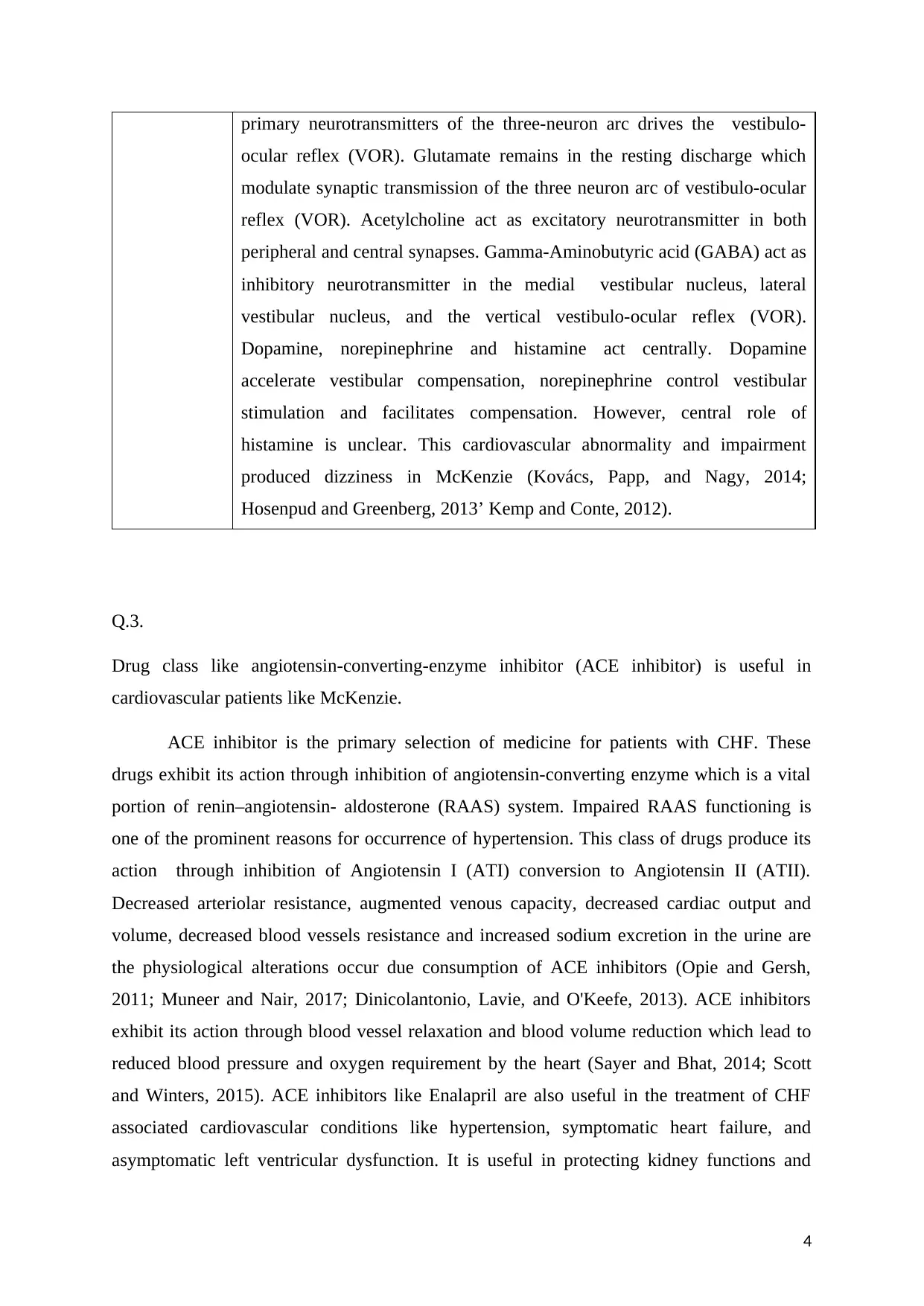
primary neurotransmitters of the three-neuron arc drives the vestibulo-
ocular reflex (VOR). Glutamate remains in the resting discharge which
modulate synaptic transmission of the three neuron arc of vestibulo-ocular
reflex (VOR). Acetylcholine act as excitatory neurotransmitter in both
peripheral and central synapses. Gamma-Aminobutyric acid (GABA) act as
inhibitory neurotransmitter in the medial vestibular nucleus, lateral
vestibular nucleus, and the vertical vestibulo-ocular reflex (VOR).
Dopamine, norepinephrine and histamine act centrally. Dopamine
accelerate vestibular compensation, norepinephrine control vestibular
stimulation and facilitates compensation. However, central role of
histamine is unclear. This cardiovascular abnormality and impairment
produced dizziness in McKenzie (Kovács, Papp, and Nagy, 2014;
Hosenpud and Greenberg, 2013’ Kemp and Conte, 2012).
Q.3.
Drug class like angiotensin-converting-enzyme inhibitor (ACE inhibitor) is useful in
cardiovascular patients like McKenzie.
ACE inhibitor is the primary selection of medicine for patients with CHF. These
drugs exhibit its action through inhibition of angiotensin-converting enzyme which is a vital
portion of renin–angiotensin- aldosterone (RAAS) system. Impaired RAAS functioning is
one of the prominent reasons for occurrence of hypertension. This class of drugs produce its
action through inhibition of Angiotensin I (ATI) conversion to Angiotensin II (ATII).
Decreased arteriolar resistance, augmented venous capacity, decreased cardiac output and
volume, decreased blood vessels resistance and increased sodium excretion in the urine are
the physiological alterations occur due consumption of ACE inhibitors (Opie and Gersh,
2011; Muneer and Nair, 2017; Dinicolantonio, Lavie, and O'Keefe, 2013). ACE inhibitors
exhibit its action through blood vessel relaxation and blood volume reduction which lead to
reduced blood pressure and oxygen requirement by the heart (Sayer and Bhat, 2014; Scott
and Winters, 2015). ACE inhibitors like Enalapril are also useful in the treatment of CHF
associated cardiovascular conditions like hypertension, symptomatic heart failure, and
asymptomatic left ventricular dysfunction. It is useful in protecting kidney functions and
4
ocular reflex (VOR). Glutamate remains in the resting discharge which
modulate synaptic transmission of the three neuron arc of vestibulo-ocular
reflex (VOR). Acetylcholine act as excitatory neurotransmitter in both
peripheral and central synapses. Gamma-Aminobutyric acid (GABA) act as
inhibitory neurotransmitter in the medial vestibular nucleus, lateral
vestibular nucleus, and the vertical vestibulo-ocular reflex (VOR).
Dopamine, norepinephrine and histamine act centrally. Dopamine
accelerate vestibular compensation, norepinephrine control vestibular
stimulation and facilitates compensation. However, central role of
histamine is unclear. This cardiovascular abnormality and impairment
produced dizziness in McKenzie (Kovács, Papp, and Nagy, 2014;
Hosenpud and Greenberg, 2013’ Kemp and Conte, 2012).
Q.3.
Drug class like angiotensin-converting-enzyme inhibitor (ACE inhibitor) is useful in
cardiovascular patients like McKenzie.
ACE inhibitor is the primary selection of medicine for patients with CHF. These
drugs exhibit its action through inhibition of angiotensin-converting enzyme which is a vital
portion of renin–angiotensin- aldosterone (RAAS) system. Impaired RAAS functioning is
one of the prominent reasons for occurrence of hypertension. This class of drugs produce its
action through inhibition of Angiotensin I (ATI) conversion to Angiotensin II (ATII).
Decreased arteriolar resistance, augmented venous capacity, decreased cardiac output and
volume, decreased blood vessels resistance and increased sodium excretion in the urine are
the physiological alterations occur due consumption of ACE inhibitors (Opie and Gersh,
2011; Muneer and Nair, 2017; Dinicolantonio, Lavie, and O'Keefe, 2013). ACE inhibitors
exhibit its action through blood vessel relaxation and blood volume reduction which lead to
reduced blood pressure and oxygen requirement by the heart (Sayer and Bhat, 2014; Scott
and Winters, 2015). ACE inhibitors like Enalapril are also useful in the treatment of CHF
associated cardiovascular conditions like hypertension, symptomatic heart failure, and
asymptomatic left ventricular dysfunction. It is useful in protecting kidney functions and
4
Secure Best Marks with AI Grader
Need help grading? Try our AI Grader for instant feedback on your assignments.
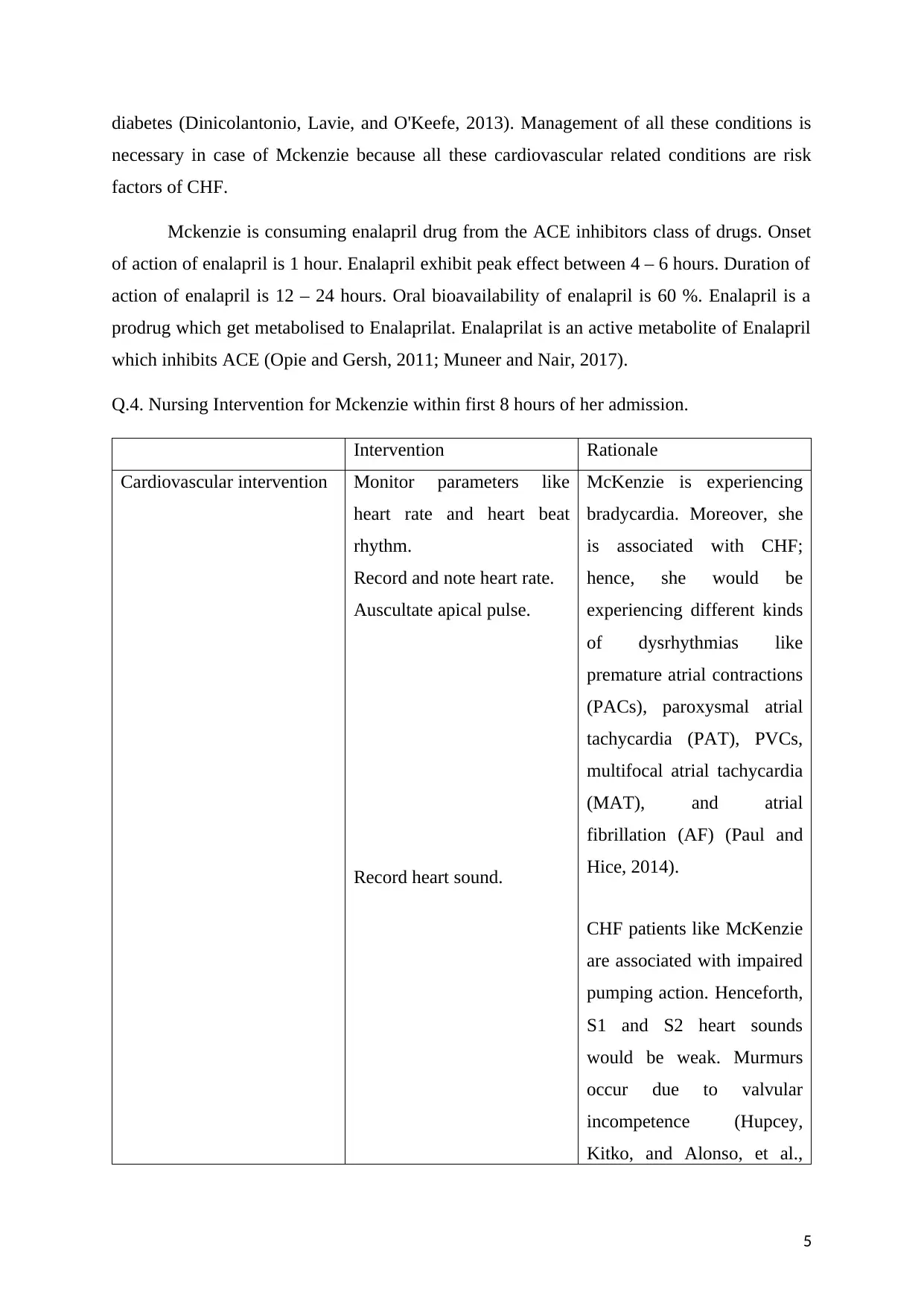
diabetes (Dinicolantonio, Lavie, and O'Keefe, 2013). Management of all these conditions is
necessary in case of Mckenzie because all these cardiovascular related conditions are risk
factors of CHF.
Mckenzie is consuming enalapril drug from the ACE inhibitors class of drugs. Onset
of action of enalapril is 1 hour. Enalapril exhibit peak effect between 4 – 6 hours. Duration of
action of enalapril is 12 – 24 hours. Oral bioavailability of enalapril is 60 %. Enalapril is a
prodrug which get metabolised to Enalaprilat. Enalaprilat is an active metabolite of Enalapril
which inhibits ACE (Opie and Gersh, 2011; Muneer and Nair, 2017).
Q.4. Nursing Intervention for Mckenzie within first 8 hours of her admission.
Intervention Rationale
Cardiovascular intervention Monitor parameters like
heart rate and heart beat
rhythm.
Record and note heart rate.
Auscultate apical pulse.
Record heart sound.
McKenzie is experiencing
bradycardia. Moreover, she
is associated with CHF;
hence, she would be
experiencing different kinds
of dysrhythmias like
premature atrial contractions
(PACs), paroxysmal atrial
tachycardia (PAT), PVCs,
multifocal atrial tachycardia
(MAT), and atrial
fibrillation (AF) (Paul and
Hice, 2014).
CHF patients like McKenzie
are associated with impaired
pumping action. Henceforth,
S1 and S2 heart sounds
would be weak. Murmurs
occur due to valvular
incompetence (Hupcey,
Kitko, and Alonso, et al.,
5
necessary in case of Mckenzie because all these cardiovascular related conditions are risk
factors of CHF.
Mckenzie is consuming enalapril drug from the ACE inhibitors class of drugs. Onset
of action of enalapril is 1 hour. Enalapril exhibit peak effect between 4 – 6 hours. Duration of
action of enalapril is 12 – 24 hours. Oral bioavailability of enalapril is 60 %. Enalapril is a
prodrug which get metabolised to Enalaprilat. Enalaprilat is an active metabolite of Enalapril
which inhibits ACE (Opie and Gersh, 2011; Muneer and Nair, 2017).
Q.4. Nursing Intervention for Mckenzie within first 8 hours of her admission.
Intervention Rationale
Cardiovascular intervention Monitor parameters like
heart rate and heart beat
rhythm.
Record and note heart rate.
Auscultate apical pulse.
Record heart sound.
McKenzie is experiencing
bradycardia. Moreover, she
is associated with CHF;
hence, she would be
experiencing different kinds
of dysrhythmias like
premature atrial contractions
(PACs), paroxysmal atrial
tachycardia (PAT), PVCs,
multifocal atrial tachycardia
(MAT), and atrial
fibrillation (AF) (Paul and
Hice, 2014).
CHF patients like McKenzie
are associated with impaired
pumping action. Henceforth,
S1 and S2 heart sounds
would be weak. Murmurs
occur due to valvular
incompetence (Hupcey,
Kitko, and Alonso, et al.,
5
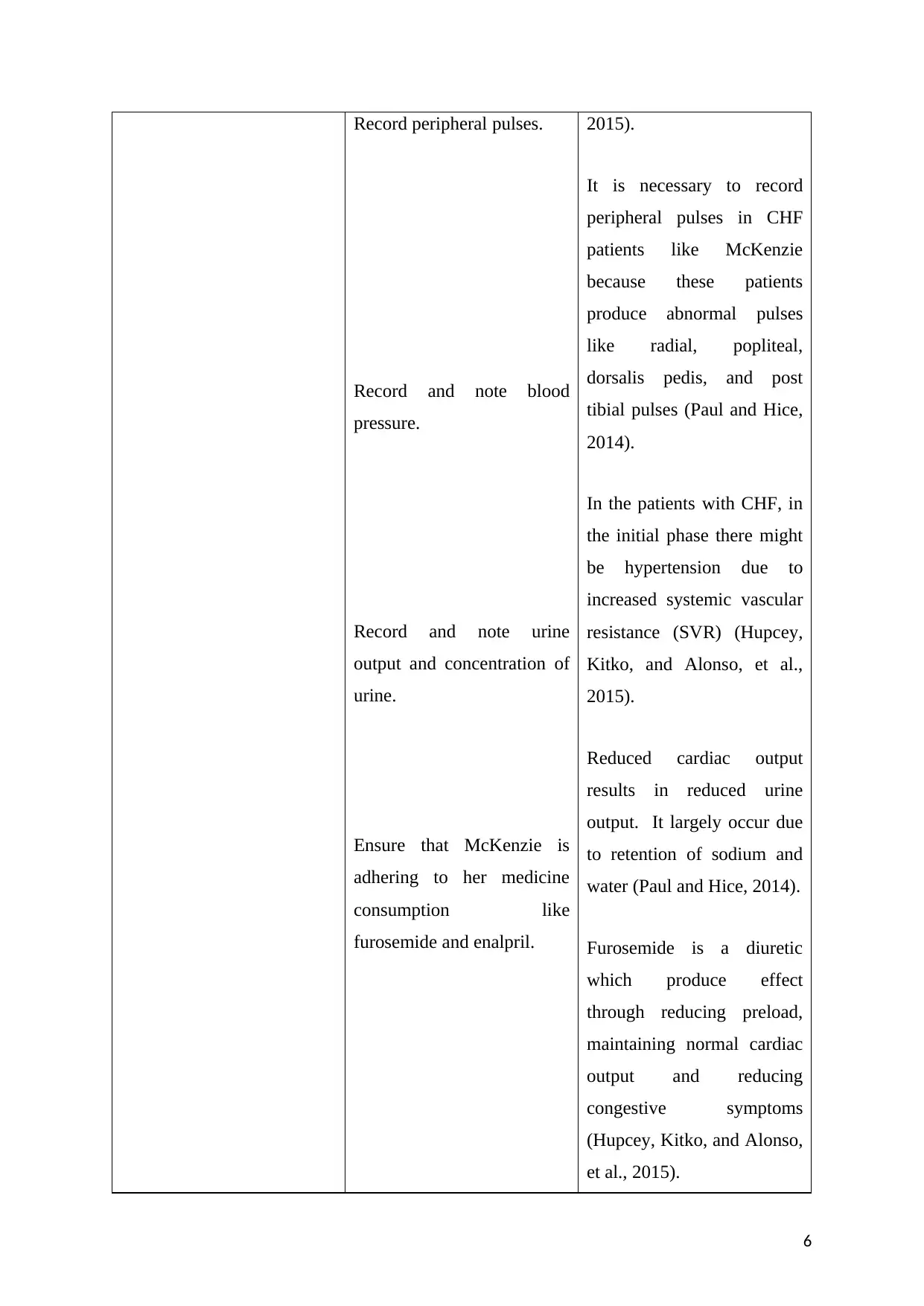
Record peripheral pulses.
Record and note blood
pressure.
Record and note urine
output and concentration of
urine.
Ensure that McKenzie is
adhering to her medicine
consumption like
furosemide and enalpril.
2015).
It is necessary to record
peripheral pulses in CHF
patients like McKenzie
because these patients
produce abnormal pulses
like radial, popliteal,
dorsalis pedis, and post
tibial pulses (Paul and Hice,
2014).
In the patients with CHF, in
the initial phase there might
be hypertension due to
increased systemic vascular
resistance (SVR) (Hupcey,
Kitko, and Alonso, et al.,
2015).
Reduced cardiac output
results in reduced urine
output. It largely occur due
to retention of sodium and
water (Paul and Hice, 2014).
Furosemide is a diuretic
which produce effect
through reducing preload,
maintaining normal cardiac
output and reducing
congestive symptoms
(Hupcey, Kitko, and Alonso,
et al., 2015).
6
Record and note blood
pressure.
Record and note urine
output and concentration of
urine.
Ensure that McKenzie is
adhering to her medicine
consumption like
furosemide and enalpril.
2015).
It is necessary to record
peripheral pulses in CHF
patients like McKenzie
because these patients
produce abnormal pulses
like radial, popliteal,
dorsalis pedis, and post
tibial pulses (Paul and Hice,
2014).
In the patients with CHF, in
the initial phase there might
be hypertension due to
increased systemic vascular
resistance (SVR) (Hupcey,
Kitko, and Alonso, et al.,
2015).
Reduced cardiac output
results in reduced urine
output. It largely occur due
to retention of sodium and
water (Paul and Hice, 2014).
Furosemide is a diuretic
which produce effect
through reducing preload,
maintaining normal cardiac
output and reducing
congestive symptoms
(Hupcey, Kitko, and Alonso,
et al., 2015).
6
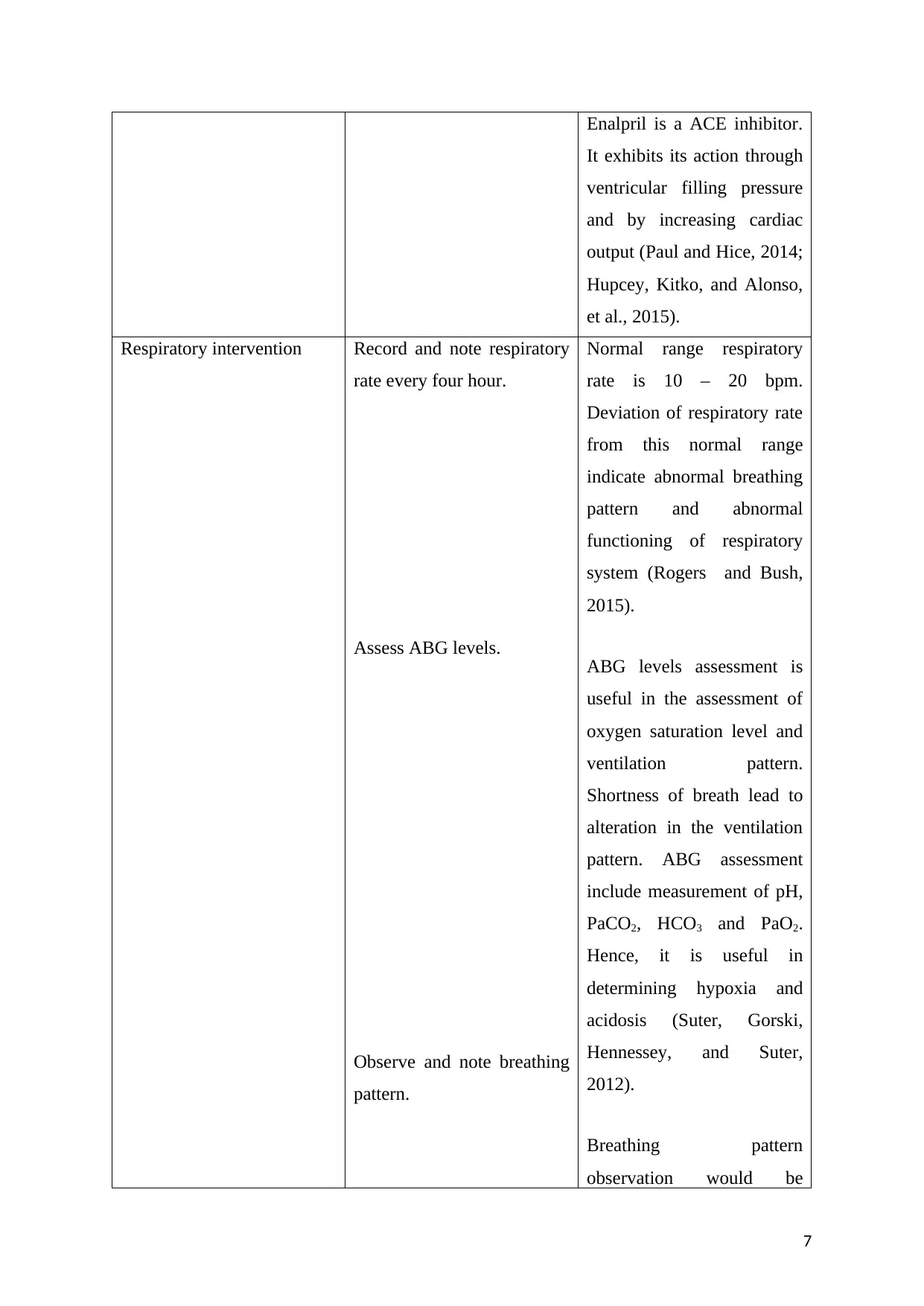
Enalpril is a ACE inhibitor.
It exhibits its action through
ventricular filling pressure
and by increasing cardiac
output (Paul and Hice, 2014;
Hupcey, Kitko, and Alonso,
et al., 2015).
Respiratory intervention Record and note respiratory
rate every four hour.
Assess ABG levels.
Observe and note breathing
pattern.
Normal range respiratory
rate is 10 – 20 bpm.
Deviation of respiratory rate
from this normal range
indicate abnormal breathing
pattern and abnormal
functioning of respiratory
system (Rogers and Bush,
2015).
ABG levels assessment is
useful in the assessment of
oxygen saturation level and
ventilation pattern.
Shortness of breath lead to
alteration in the ventilation
pattern. ABG assessment
include measurement of pH,
PaCO2, HCO3 and PaO2.
Hence, it is useful in
determining hypoxia and
acidosis (Suter, Gorski,
Hennessey, and Suter,
2012).
Breathing pattern
observation would be
7
It exhibits its action through
ventricular filling pressure
and by increasing cardiac
output (Paul and Hice, 2014;
Hupcey, Kitko, and Alonso,
et al., 2015).
Respiratory intervention Record and note respiratory
rate every four hour.
Assess ABG levels.
Observe and note breathing
pattern.
Normal range respiratory
rate is 10 – 20 bpm.
Deviation of respiratory rate
from this normal range
indicate abnormal breathing
pattern and abnormal
functioning of respiratory
system (Rogers and Bush,
2015).
ABG levels assessment is
useful in the assessment of
oxygen saturation level and
ventilation pattern.
Shortness of breath lead to
alteration in the ventilation
pattern. ABG assessment
include measurement of pH,
PaCO2, HCO3 and PaO2.
Hence, it is useful in
determining hypoxia and
acidosis (Suter, Gorski,
Hennessey, and Suter,
2012).
Breathing pattern
observation would be
7
Paraphrase This Document
Need a fresh take? Get an instant paraphrase of this document with our AI Paraphraser
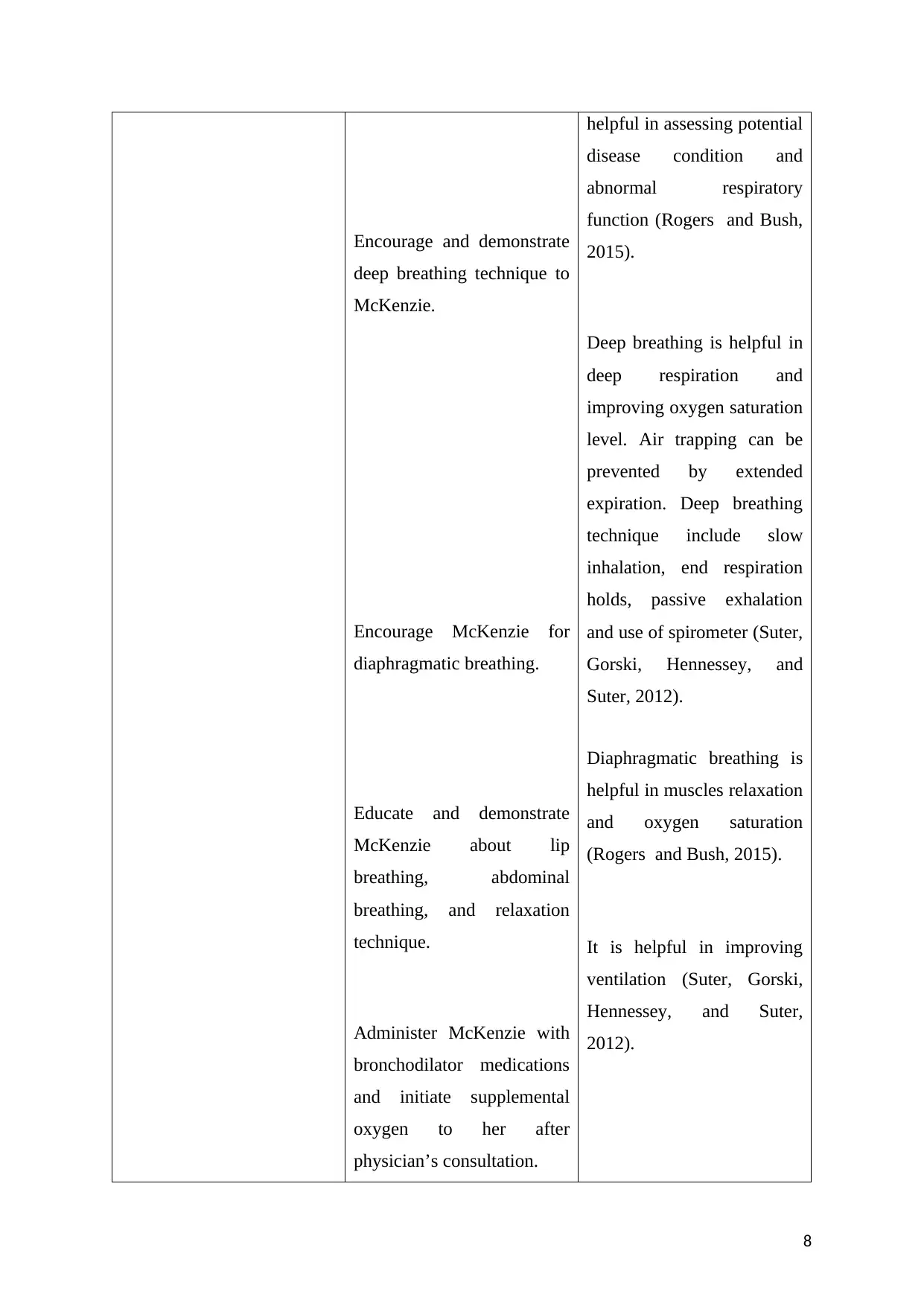
Encourage and demonstrate
deep breathing technique to
McKenzie.
Encourage McKenzie for
diaphragmatic breathing.
Educate and demonstrate
McKenzie about lip
breathing, abdominal
breathing, and relaxation
technique.
Administer McKenzie with
bronchodilator medications
and initiate supplemental
oxygen to her after
physician’s consultation.
helpful in assessing potential
disease condition and
abnormal respiratory
function (Rogers and Bush,
2015).
Deep breathing is helpful in
deep respiration and
improving oxygen saturation
level. Air trapping can be
prevented by extended
expiration. Deep breathing
technique include slow
inhalation, end respiration
holds, passive exhalation
and use of spirometer (Suter,
Gorski, Hennessey, and
Suter, 2012).
Diaphragmatic breathing is
helpful in muscles relaxation
and oxygen saturation
(Rogers and Bush, 2015).
It is helpful in improving
ventilation (Suter, Gorski,
Hennessey, and Suter,
2012).
8
deep breathing technique to
McKenzie.
Encourage McKenzie for
diaphragmatic breathing.
Educate and demonstrate
McKenzie about lip
breathing, abdominal
breathing, and relaxation
technique.
Administer McKenzie with
bronchodilator medications
and initiate supplemental
oxygen to her after
physician’s consultation.
helpful in assessing potential
disease condition and
abnormal respiratory
function (Rogers and Bush,
2015).
Deep breathing is helpful in
deep respiration and
improving oxygen saturation
level. Air trapping can be
prevented by extended
expiration. Deep breathing
technique include slow
inhalation, end respiration
holds, passive exhalation
and use of spirometer (Suter,
Gorski, Hennessey, and
Suter, 2012).
Diaphragmatic breathing is
helpful in muscles relaxation
and oxygen saturation
(Rogers and Bush, 2015).
It is helpful in improving
ventilation (Suter, Gorski,
Hennessey, and Suter,
2012).
8

Bronchodilator medicines
exhibit its effect through
improvement in
bronchodilation and opening
the airway passage (Rogers
and Bush, 2015).
References:
Australian Institute of Health and Welfare (2014). Cardiovascular disease, diabetes and
chronic kidney disease— Australian facts: Prevalence and incidence. In:
Cardiovascular, diabetes and chronic kidney disease series no. 2. Cat. no. CDK 2.
Canberra. Retrieved from https://www.aihw.gov.au/reports/heart-stroke-vascular-
disease/cardiovascular-diabetes-chronic-kidney-prevalence/contents/table-of-contents
on 14.03.2019.
Castillo, A., Edriss, H., Selvan, K., and Nugent K. (2017). Characteristics of Patients With
Congestive Heart Failure or Chronic Obstructive Pulmonary Disease Readmissions
Within 30 Days Following an Acute Exacerbation. Quality Management in
Healthcare, 26(3), 152-159.
Cooper, L.B., DeVore, A.D., and Michael Felker, G. (2015). The Impact of Worsening Heart
Failure in the United States. Heart Failure Clinics, 11(4), 603-14.
Dhingra, A., Garg, A., Kaur, S., Chopra, S., Batra, J.S., Pandey, A., Chaanine, A.H., and
Agarwal SK. (2014). Epidemiology of heart failure with preserved ejection fraction.
Current Heart Failure Reports, 11(4), 354-65.
Dinicolantonio, J.J., Lavie, C.J., and O'Keefe, J.H. (2013). Not all angiotensin-converting
enzyme inhibitors are equal: focus on ramipril and perindopril. Postgraduate
Medicine, 125(4), 154-68.
Eisen, H. J. (2014). Heart Failure, An Issue of Cardiology Clinics, E-Book. Elsevier Health
Sciences. New York. United States.
Gotto Jr, A. M., Lenfant, C., Paoletti, R., Alberico L. Catapano, A. S. (2012). Multiple Risk
Factors in Cardiovascular Disease: Strategies of Prevention of Coronary Heart
Disease, Cardiac Failure. Springer. Science & Business Media. Berlin, Germany,
Güde, G., Brenner, S., Störk, S., Hoes, A., and Rutten, H. (2014). Chronic obstructive
pulmonary disease in heart failure: accurate diagnosis and treatment. European
Journal of Heart
Failure, 16(12), 1273-82.
Hosenpud, J. D., and Greenberg, B. H. (2013). Congestive Heart Failure: Pathophysiology,
Diagnosis, and Comprehensive Approach to Management. Springer Science &
Business Media. Berlin, Germany.
Hupcey, J.E., Kitko, L., and Alonso, W. (2015). Palliative Care in Heart Failure. Critical
Care Nursing Clinics of North America, 27(4), 577-87.
Kemp, C.D., and Conte, J.V. (2012). The pathophysiology of heart failure. Cardiovascular
Pathology, 21(5), 365-71.
9
exhibit its effect through
improvement in
bronchodilation and opening
the airway passage (Rogers
and Bush, 2015).
References:
Australian Institute of Health and Welfare (2014). Cardiovascular disease, diabetes and
chronic kidney disease— Australian facts: Prevalence and incidence. In:
Cardiovascular, diabetes and chronic kidney disease series no. 2. Cat. no. CDK 2.
Canberra. Retrieved from https://www.aihw.gov.au/reports/heart-stroke-vascular-
disease/cardiovascular-diabetes-chronic-kidney-prevalence/contents/table-of-contents
on 14.03.2019.
Castillo, A., Edriss, H., Selvan, K., and Nugent K. (2017). Characteristics of Patients With
Congestive Heart Failure or Chronic Obstructive Pulmonary Disease Readmissions
Within 30 Days Following an Acute Exacerbation. Quality Management in
Healthcare, 26(3), 152-159.
Cooper, L.B., DeVore, A.D., and Michael Felker, G. (2015). The Impact of Worsening Heart
Failure in the United States. Heart Failure Clinics, 11(4), 603-14.
Dhingra, A., Garg, A., Kaur, S., Chopra, S., Batra, J.S., Pandey, A., Chaanine, A.H., and
Agarwal SK. (2014). Epidemiology of heart failure with preserved ejection fraction.
Current Heart Failure Reports, 11(4), 354-65.
Dinicolantonio, J.J., Lavie, C.J., and O'Keefe, J.H. (2013). Not all angiotensin-converting
enzyme inhibitors are equal: focus on ramipril and perindopril. Postgraduate
Medicine, 125(4), 154-68.
Eisen, H. J. (2014). Heart Failure, An Issue of Cardiology Clinics, E-Book. Elsevier Health
Sciences. New York. United States.
Gotto Jr, A. M., Lenfant, C., Paoletti, R., Alberico L. Catapano, A. S. (2012). Multiple Risk
Factors in Cardiovascular Disease: Strategies of Prevention of Coronary Heart
Disease, Cardiac Failure. Springer. Science & Business Media. Berlin, Germany,
Güde, G., Brenner, S., Störk, S., Hoes, A., and Rutten, H. (2014). Chronic obstructive
pulmonary disease in heart failure: accurate diagnosis and treatment. European
Journal of Heart
Failure, 16(12), 1273-82.
Hosenpud, J. D., and Greenberg, B. H. (2013). Congestive Heart Failure: Pathophysiology,
Diagnosis, and Comprehensive Approach to Management. Springer Science &
Business Media. Berlin, Germany.
Hupcey, J.E., Kitko, L., and Alonso, W. (2015). Palliative Care in Heart Failure. Critical
Care Nursing Clinics of North America, 27(4), 577-87.
Kemp, C.D., and Conte, J.V. (2012). The pathophysiology of heart failure. Cardiovascular
Pathology, 21(5), 365-71.
9

Kovács, Á., Papp, Z., and Nagy, L. (2014). Causes and pathophysiology of heart failure
preserved ejection fraction. Heart Failure Clinics, 10(3), 389-98.
Mahmood, S. S., and Wang, T. J. (2013). The epidemiology of congestive heart failure: the
Framingham Heart Study perspective. Global Heart, 8(1), 77–82.
Mirkin, K.A., Enomoto, L.M., Caputo, G.M., and Hollenbeak, C.S. (2017). Risk factors for
30-day readmission in patients with congestive heart failure. Heart Lung, 46(5), 357-
362.
Moe, G. (2016). Heart failure with multiple comorbidities. Current Opinion in Cardiology,
31(2), 209-16.
Muneer, K., and Nair, A. (2017). Angiotensin-converting enzyme inhibitors and receptor
blockers in heart failure and chronic kidney disease - Demystifying controversies.
Indian Heart Journal, 69(3), 371-374.
Opie, L. H., and Gersh, B. J. (2011). Drugs for the Heart E-Book. Elsevier Health Sciences.
New York. United States.
Paul, S., and Hice, A. (2014). Role of the acute care nurse in managing patients with heart
failure using evidence-based care. Critical Care Nursing Q, 37(4), 357-76.
Raman, J. (2016). Management of Heart Failure (2nd ed.). Springer. Berlin, Germany.
Rogers, C., and Bush, N. (2015). Heart Failure: Pathophysiology, Diagnosis, Medical
Treatment Guidelines, and Nursing Management. Nursing Clinics of North America,
50(4), 787-99.
Sayer, G., and Bhat, G. (2014). The renin-angiotensin-aldosterone system and heart failure.
Cardiology Clinics, 32(1), 21-32.
Scott, M.C., and Winters, M.E. (2015). Congestive Heart Failure. Emergency Medicine
Clinics of North America, 33(3), 553-62.
Díaz-Toro, F., Verdejo, H.E., and Castro, P.F. (2015). Socioeconomic Inequalities in Heart
Failure. Heart Failure Clinics, 11(4), 507-13
Suter, P.M., Gorski, L.A., Hennessey, B., and Suter, W.N. (2012). Best practices for heart
failure: a focused review. Home Healthcare Nurse, 30(7), 394-405.
10
preserved ejection fraction. Heart Failure Clinics, 10(3), 389-98.
Mahmood, S. S., and Wang, T. J. (2013). The epidemiology of congestive heart failure: the
Framingham Heart Study perspective. Global Heart, 8(1), 77–82.
Mirkin, K.A., Enomoto, L.M., Caputo, G.M., and Hollenbeak, C.S. (2017). Risk factors for
30-day readmission in patients with congestive heart failure. Heart Lung, 46(5), 357-
362.
Moe, G. (2016). Heart failure with multiple comorbidities. Current Opinion in Cardiology,
31(2), 209-16.
Muneer, K., and Nair, A. (2017). Angiotensin-converting enzyme inhibitors and receptor
blockers in heart failure and chronic kidney disease - Demystifying controversies.
Indian Heart Journal, 69(3), 371-374.
Opie, L. H., and Gersh, B. J. (2011). Drugs for the Heart E-Book. Elsevier Health Sciences.
New York. United States.
Paul, S., and Hice, A. (2014). Role of the acute care nurse in managing patients with heart
failure using evidence-based care. Critical Care Nursing Q, 37(4), 357-76.
Raman, J. (2016). Management of Heart Failure (2nd ed.). Springer. Berlin, Germany.
Rogers, C., and Bush, N. (2015). Heart Failure: Pathophysiology, Diagnosis, Medical
Treatment Guidelines, and Nursing Management. Nursing Clinics of North America,
50(4), 787-99.
Sayer, G., and Bhat, G. (2014). The renin-angiotensin-aldosterone system and heart failure.
Cardiology Clinics, 32(1), 21-32.
Scott, M.C., and Winters, M.E. (2015). Congestive Heart Failure. Emergency Medicine
Clinics of North America, 33(3), 553-62.
Díaz-Toro, F., Verdejo, H.E., and Castro, P.F. (2015). Socioeconomic Inequalities in Heart
Failure. Heart Failure Clinics, 11(4), 507-13
Suter, P.M., Gorski, L.A., Hennessey, B., and Suter, W.N. (2012). Best practices for heart
failure: a focused review. Home Healthcare Nurse, 30(7), 394-405.
10
1 out of 10
Related Documents
Your All-in-One AI-Powered Toolkit for Academic Success.
+13062052269
info@desklib.com
Available 24*7 on WhatsApp / Email
![[object Object]](/_next/static/media/star-bottom.7253800d.svg)
Unlock your academic potential
© 2024 | Zucol Services PVT LTD | All rights reserved.





